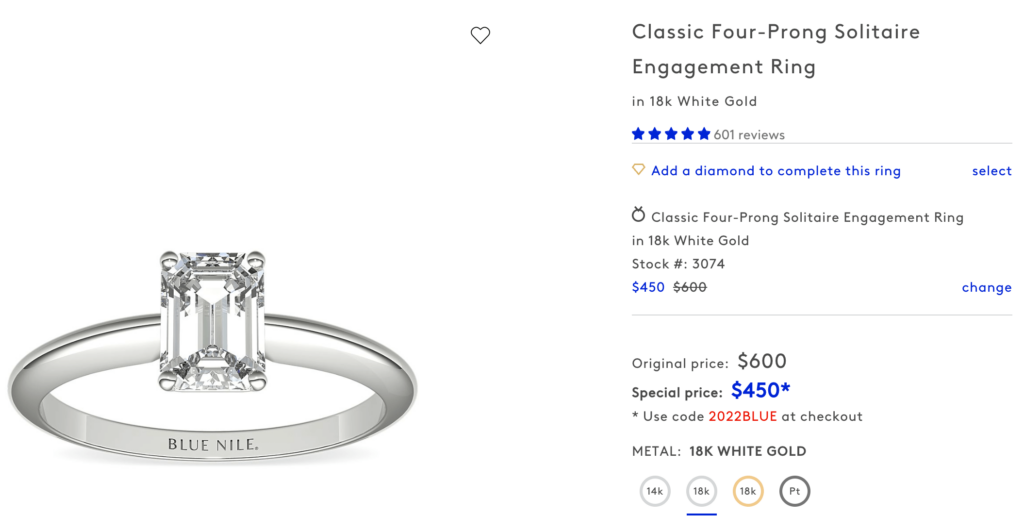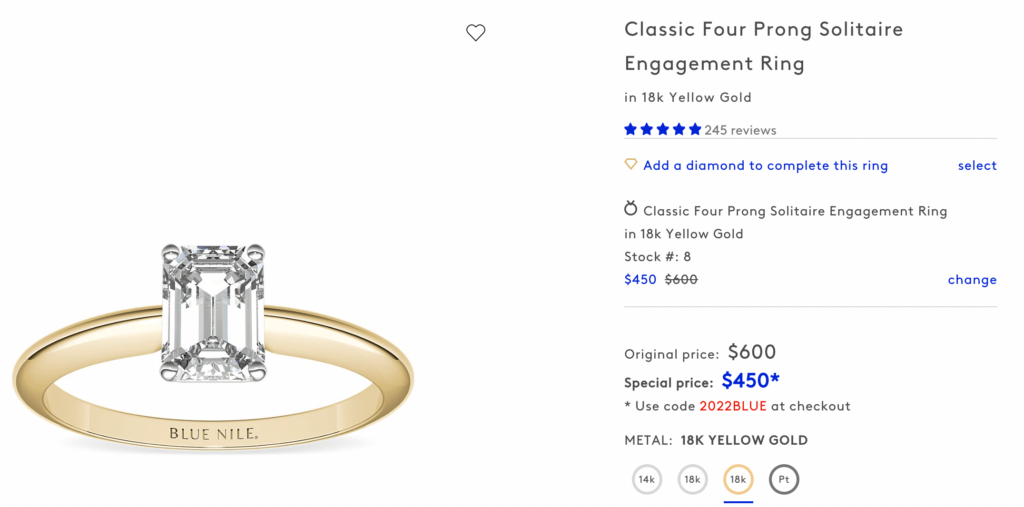If you are deciding between white gold and yellow gold — perhaps for an engagement ring — or you have white gold or yellow gold pieces to sell, you’ve come to the right place.
White gold and yellow gold are both timeless and similarly priced, so which one you choose will largely depend on your style preferences. In this post, we’ll give you all the info you need to select the right metal for you (or your partner):
What are the differences between white gold and yellow gold?
Rhodium plating and white gold FAQs
Bottom line: Is white gold worth more than yellow gold? Which has the better resale value?
If you’re looking to sell either type of gold, we recommend selling to CashforGoldUSA, a top online gold buyer with an A+ BBB rating and payments within 24 hours.
Get an offer for your white or yellow gold from CashforGoldUSA >>
What is the difference between white gold and yellow gold?
Beyond their obvious color difference, white gold and yellow gold are alloys (a mixture of metals) composed of different types of metals. White gold is also typically plated with a layer of rhodium, which gives it its white appearance.
The amount of pure gold in both yellow gold and white gold is dependent upon its karat weight (which is typically stamped on jewelry):
- 24k gold = 99.9% pure
- 18k gold = 75% pure
- 14k gold = 58.3% pure
According to the United States Geological Survey, white gold became popular in the 1920s as a less expensive alternative to platinum, which typically costs hundreds more in a ring setting.
Historically, both gold alloys have traded off popularity, with yellow gold currently making a comeback in engagement ring fashion (thanks in part to Prince Harry and Meghan Markle).
What’s yellow gold made of?
Yellow gold is an alloy of pure gold and metals like copper and zinc.
What’s white gold made of?
White gold is an alloy of pure gold and white metals like silver, nickel, palladium, or zinc, which give it an off-white, less yellow appearance. White gold is often plated in rhodium to achieve a whiter color and increase its durability and shine.
Is white gold real gold?
Yes! White gold is real gold alloyed with other metals like silver, nickel, or palladium.
Sterling silver vs. plated silver vs. white gold
Rhodium plating and white gold FAQs
Rhodium is a rare platinum group metal commonly used to plate white gold.
What is rhodium plating?
Rhodium plating is a thin layer of rhodium that coats other metals, typically white gold, to make it appear pure white and to make it more durable and reflective.
Rhodium is actually the most expensive metal in the world at nearly $12,150 per ounce as of February 2023. However, its hard and brittle nature — as well as its exorbitant cost — means it cannot be used in its pure form to make jewelry.
How long does rhodium last on white gold?
Rhodium plating fades over time to reveal the warmer white gold underneath, especially with frequent wear and exposure to chemicals like chlorine. According to New York City jeweler Frank Darling, you’ll need to have it replated every six months to a year to maintain its white appearance.
Is rhodium plating white gold a good idea?
That depends on your personal preferences and whether you want to spend money to have your rhodium-plated jewelry replated every six months to a year. The cost of rhodium plating varies by jeweler and the thickness of the plating, though it typically costs less than $100 for an engagement ring.
Rhodium is also hypoallergenic, so if you have a nickel allergy but want a white gold piece, it can protect your skin.
On their own, most of today’s white gold mixtures do appear white, with a slightly warm hue. You may only notice a color difference if your white gold piece is placed next to a platinum or rhodium-plated piece. If you are happy with this warmer, off-white color, you do not need to have your white gold plated.
Yellow gold FAQs
Gold is a simple metal found on the Periodic Table of Elements — yet it is deeply mysterious, primed for scams throughout history, and requires some basic education.
Here are some terms you may encounter:
What is gold vermeil?
Gold vermeil is sterling silver that has been gold-plated, typically with 22K to 24K gold. It is more common to find gold vermeil in 14K-18K.
What is “gold plated?”
Gold plating involves affixing a thin layer of gold onto the surface of another metal — like copper or silver — by a chemical or electrochemical plating process.
Gold-plated jewelry typically doesn't have resale value. Learn more about how to tell if gold is real.
What is “gold filled?”
Gold-filled jewelry is constructed in two or three layers: The core metal is brass, and a gold alloy is then bonded to one or both surfaces of the brass core with heat and pressure. Gold-filled jewelry contains a much thicker layer of gold than plated or vermeil items and will hold up better with wear comparatively.
What's the difference between gold, gold filled, and gold plated?
Unlike plated (also referred to as “electroplated” or “dipped”) gold, gold-filled items are legally required to contain 5% gold by weight. “Gold” items are the same gold alloy all the way through.
Pros and cons of yellow gold
If you’re shopping for a yellow gold piece of jewelry, you should keep these things in mind:
Pros
- Will not need to be replated
- If your diamond is slightly yellow, yellow gold will do a better job of hiding its yellow color
- Provides a beautiful contrast to most colorless and colored gemstones
Cons
- More prone to scratching than white gold
Pros and cons of white gold
These are some pros and cons of choosing a white gold piece:
Pros
- Alloyed with stronger metals than yellow gold, making it more resistant to scratching and regular wear
- Rhodium plating provides an extra layer of protection and shine
Cons
- Needs to be replated every six months to a year to maintain its pure white color, which can cost $50-100 each time (depending on the jeweler and size of your jewelry)
- Decreased in popularity in recent years, though trends are always changing
- All about selling gold by searching “sell gold near me”
White vs yellow gold FAQs
Common questions about the qualities of the different gold colors:
White gold vs yellow gold price
White gold and yellow gold of the same karat weight contain the same amount of pure gold, so most white gold and yellow gold pieces have relatively similar (or the same) prices. Any price differences will be a reflection of current trends/demand of either gold type.
For example, this Blue Nile engagement ring setting is the same price in both 18k white gold and 18k yellow gold:


Is yellow or white gold more popular?
The Knot 2021 Jewelry & Engagement Study surveyed more than 5,000 recently engaged couples and found that yellow gold ring settings have increased in popularity by 11% since 2017, though white gold settings remain the most popular choice at 45% of all engagement ring settings (down from 61% in 2017).
Vox Media credits Meghan Markle’s yellow gold engagement ring (with side stones from his mother Princess Diana’s jewelry collection) for the recent resurgence of yellow gold, though yellow gold overall has regained popularity in recent years.
Do diamonds look better in white or yellow gold?
According to the International Gem Society, a yellow gold setting is more forgiving for diamonds that have a nearly colorless or faint color, making them appear whiter in contrast.
If you have a colorless diamond, white gold can enhance its white color, while yellow gold will show through your diamond to give it a slightly yellow hue.
However, whether you choose white or yellow gold is primarily a personal preference.
White gold vs yellow gold engagement ring?
Whether you choose a white gold vs. yellow gold engagement ring depends on your personal style preferences and the color of the gemstone you choose.
If you want a contrasting look or you have a diamond with a slightly yellow color, a yellow gold setting might be best. You can also buy a two-tone engagement ring, where the band is yellow gold and the ring prongs are white gold or platinum to reduce the amount of yellow that shows through your diamond.
White gold engagement ring settings continue to be the most popular among engaged couples, according to a 2021 survey by The Knot, though yellow gold has increased in popularity in recent years.
Which is more durable?
Because the metals it's alloyed with are more durable and because it’s typically plated in rhodium, white gold is more durable and resistant to scratching than yellow gold.
Bottom line: Is white gold worth more than yellow gold? Which has the better resale value?
White gold and yellow gold of the same karat weight have about the same value. If you were to sell either for scrap, you would get about the same value from a gold buyer.
As of April 20,2025, the spot gold value in the United States was trading at $3317.23 per ounce, or $117.01 per gram.
Whether you’re looking to sell white gold or yellow gold jewelry, we recommend selling to CashforGoldUSA, one of the oldest and most reputable online gold buyers.
CashforGoldUSA is our top choice because:
- A+ Better Business Bureau rating
- 100% free door-to-door, trackable FedEx or USPS shipping
- Free Jewelers’ Mutual insurance up to $150,000 on each shipment
- No minimum value
- Facility insured by Lloyds of London
CashforGoldUSA also has a highest price guarantee for all of your gold, silver, and diamond jewelry.
Beyond their obvious color difference, white gold and yellow gold are alloys (a mixture of metals) composed of different types of metals. White gold is also typically plated with a layer of rhodium, which gives it its white appearance.
Yellow gold is an alloy of pure gold and metals like copper and zinc.
White gold is an alloy of pure gold and white metals like silver, nickel, palladium, or zinc, which give it an off-white, less yellow appearance. White gold is often plated in rhodium to achieve a whiter color and increase its durability and shine.
White gold is real gold alloyed with other metals like silver, nickel, or palladium.
Rhodium plating is a thin layer of rhodium that coats other metals, typically white gold, to make it appear pure white and to make it more durable and reflective.
Rhodium plating fades over time to reveal the warmer white gold underneath, especially with frequent wear and exposure to chemicals like chlorine.
That depends on your personal preferences and whether you want to spend money to have your rhodium-plated jewelry replated every six months to a year. The cost of rhodium plating varies by jeweler and the thickness of the plating, though is typically less than $100 for an engagement ring.
Gold vermeil is sterling silver that has been gold-plated, typically with 22K to 24K gold. It is more common to find gold vermeil in 14K-18K.
Gold plating involves affixing a thin layer of gold onto the surface of another metal — like copper or silver — by a chemical or electrochemical plating process.
Gold-filled jewelry is constructed in two or three layers: The core metal is brass, and a gold alloy is then bonded to one or both surfaces of the brass core with heat and pressure.

